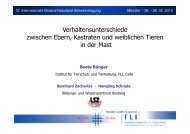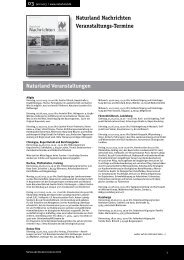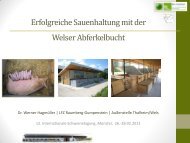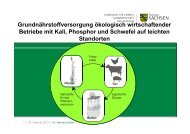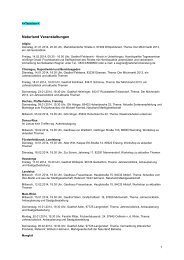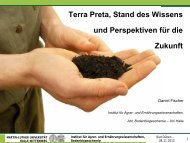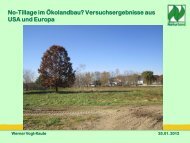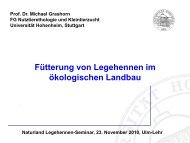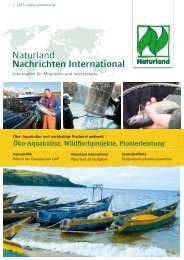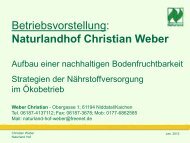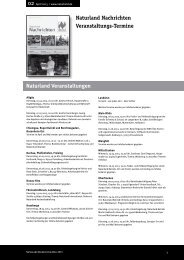Organic Farming in the Tropics and Subtropics: Sesame - Naturland
Organic Farming in the Tropics and Subtropics: Sesame - Naturland
Organic Farming in the Tropics and Subtropics: Sesame - Naturland
Create successful ePaper yourself
Turn your PDF publications into a flip-book with our unique Google optimized e-Paper software.
II Special section: <strong>Organic</strong> Cultivation of <strong>Sesame</strong><br />
In <strong>the</strong> case of organic sesame cultivation <strong>in</strong> El Salvador, <strong>the</strong> yield is around 450-520<br />
kg/ha sorted seeds; 350 kg/ha are required to meet production costs <strong>the</strong>re 1 . In<br />
Nicaragua, 350-400 kg/ha 2 are harvested on average. Cultivation here is often<br />
endangered by <strong>the</strong> harvest <strong>and</strong> ra<strong>in</strong>y seasons occurr<strong>in</strong>g simultaneously . <strong>Organic</strong><br />
farmers <strong>in</strong> Peru can harvest up to 800 kg/ha. The world average for conventional<br />
sesame cultivations is around 330 kg/ha.<br />
1.3. Uses <strong>and</strong> contents<br />
In many of <strong>the</strong> countries <strong>in</strong> Africa <strong>and</strong> Asia, <strong>the</strong> cultivation of sesame plays hardly<br />
any role <strong>in</strong> cash products, because sesame here is one of <strong>the</strong> staple, daily<br />
foodstuffs. Throughout wide regions of Africa, <strong>the</strong> cultivation of staple-food crops –<br />
<strong>in</strong>clud<strong>in</strong>g, for example, peanuts – is seen as a woman’s chore. The cultivation of<br />
cash crops such as, e.g. cotton, is seen as a male duty. Therefore, cultivat<strong>in</strong>g<br />
sesame as a cash crop is accompanied by changes <strong>in</strong> cultural <strong>and</strong> social<br />
traditions 3 .<br />
In West Africa, <strong>the</strong> shoots <strong>and</strong> young leaves of <strong>the</strong> varieties S. alatum <strong>and</strong> S.<br />
radiatum are eaten as a vegetable. <strong>Sesame</strong> seeds are ei<strong>the</strong>r consumed directly as<br />
a highly nutritious foodstuff, or processed by <strong>the</strong> confectionery <strong>and</strong> bakery<br />
<strong>in</strong>dustries. The seed hulls, which are bitter due to <strong>the</strong>ir oxalic content, can be<br />
removed with <strong>the</strong> use of steam. Ragouts <strong>and</strong> soups are often prepared with crushed<br />
sesame seeds. <strong>Sesame</strong> hay, if carefully dried, can be used as fodder.<br />
A large proportion of <strong>the</strong> world‘s sesame production goes towards produc<strong>in</strong>g edible<br />
oil. The plant’s oil content lies around 40-60%; prote<strong>in</strong> content ranges between 17-<br />
29%. The oil won dur<strong>in</strong>g <strong>the</strong> first, cold press<strong>in</strong>g is one of <strong>the</strong> costliest produced. The<br />
oil is light yellow, does not dry out, <strong>and</strong> can be used with strong heat. The quality of<br />
<strong>the</strong> oil depends largely <strong>in</strong> its essential l<strong>in</strong>oleic acid content (35-41% of all <strong>the</strong> oils).<br />
The oil resists oxidative rancidity, due to its anti-oxidants sesam<strong>in</strong> <strong>and</strong> sesamol<strong>in</strong>.<br />
The press cakes conta<strong>in</strong> 40-70% prote<strong>in</strong> <strong>and</strong> also 12% fat, <strong>and</strong> are an excellent<br />
supply of fodder.<br />
Purely white sesame seeds are <strong>in</strong> just as much dem<strong>and</strong> on conventional as on<br />
ecological markets, because of <strong>the</strong>ir higher oil content than pigmented varieties.<br />
<strong>Sesame</strong> oil obta<strong>in</strong>ed from <strong>the</strong> second, warm press<strong>in</strong>g <strong>and</strong> extraction has a lower<br />
quality than cold-pressed. It is generally used <strong>in</strong> <strong>the</strong> manufacture of soaps, pa<strong>in</strong>t,<br />
cosmetics <strong>and</strong> pharmaceutical products.<br />
1 AGRODESA (1997): Manual de ajonjolí orgánico. San Salvador.<br />
2 CLUSA (1995): Producción orgánica de ajonjolí. Serie de documentos técnicos, Managua.<br />
3 Page, S. (1998): Personal Note<br />
Naturl<strong>and</strong> e.V. – 1 st edition 2000 Page 2




